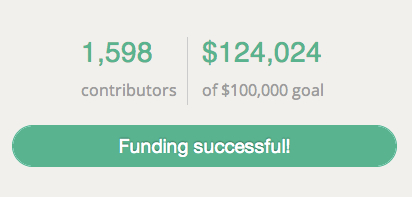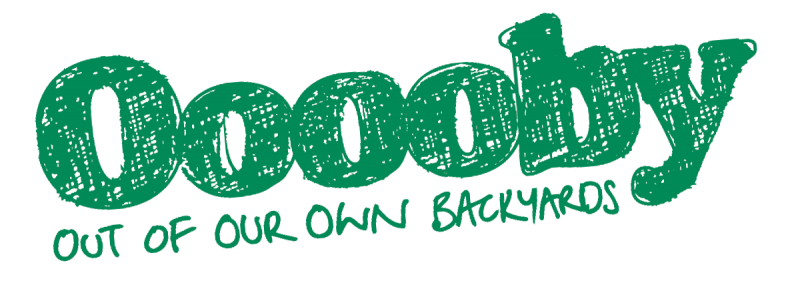- Home
- About
- Local groups
- Community
- News
- Resources
- Offer Support
- Contact us
James Samuel's blog
Ooooby is Crowdfunding
Submitted by James Samuel on 15 August 2015 - 3:00pm | updated 15 Aug 2015 | Blog entryOoooby’s mission is to make local food convenient, affordable and fair everywhere. To do this it has developed a lean-efficient distribution model, that can scale by being replicated to serve the local food needs of any modest sized population. This social enterprise aligns well with the Transition Towns philosophy of moving from oil dependence to local resilience, and is a commons based business, which means that suppliers, customers and crew all share in its success.
Changing the way we grow (and distribute) food
Submitted by James Samuel on 16 February 2015 - 12:58pm | updated 16 Feb 2015 | Blog entry Over the past few decades we've learned how to move beyond the monoculture model of production, to work with nature and grow food, while enhancing and regenerating ecological systems.
Over the past few decades we've learned how to move beyond the monoculture model of production, to work with nature and grow food, while enhancing and regenerating ecological systems.
The Beyond Organic NZ Tour with Stefan Sobkowiak is an opportunity to hear how these productive, profitable, permaculture-inspired practices work and learn techniques you can apply immediately. Read on to see the video trailer of Stefan's 2-hour Permaculture Orchard film.
An extensive calendar of 20 events has been created, from Matakana to the Wairarapa and Motueka to Arrowtown. If you're curious and want to know what these best-practice food growing methods look like register today and you can look forward to discovering valuable information and meeting others who can support you and your goals.
Stefan Sobkowiak – Beyond Organic
Submitted by James Samuel on 30 August 2014 - 4:42pm | Blog entryThis two hour interview makes for an important addition to the knowledge shared in the Permaculture Orchard film. In it Stefan talks about the next piece of the puzzle, soon to be released from Miracle Farm.
The podcast which has just come online, would have gone longer if Stefan hadn’t excused himself to join a scheduled conversation with John Allan of APW and myself. We needed to talk about the Masterclass Stefan will be leading at Unitec Auckland next year, as part of the Beyond Organic NZ Tour.
 For New Zealanders the survivalist concepts that are promoted in the lead-in may seem foreign, and you can of course skip them and jump to 8m:40sec, or you may wind up asking, what’s happening in the USA? What’s being expressed there is an expression of people responding to the increasing uncertainty and rapid change that is underway across the world – we’re just each experiencing it differently.
For New Zealanders the survivalist concepts that are promoted in the lead-in may seem foreign, and you can of course skip them and jump to 8m:40sec, or you may wind up asking, what’s happening in the USA? What’s being expressed there is an expression of people responding to the increasing uncertainty and rapid change that is underway across the world – we’re just each experiencing it differently.
Now, onto the interview on The Survival Podcast with Jack Spirko.
Up front we hear about Stefan’s background and having a Masters degree in both Biology and Landscape design, before learning what got him inspired to set up a Permaculture Orchard. We find a man with a deep desire to maximise the positive impact he can have on the world around him, and as the minutes turn into hours, we start to appreciate the gifts he’s offering.
Ripples from the Occupy movement
Submitted by James Samuel on 19 April 2014 - 5:45pm | updated 19 Apr 2014 | Blog entryIt's been nearly three years since the Occupy movement burst onto the stage and made it's splash. It highlighted global inequities and the failures of big power and money to ensure we attend to the well-being of all members of society.
One of the ripples has come from of a small group of people in Wellington, who have focussed on building tools to facilitate the discussion and consensus decision making process across groups, without them having to be in the same place at the same time.
 From a foundation of several successes under its belt, that include the tool being translated into multiple languages, www.loomio.org launched a crowd-funding campaign a month ago, with a goal of $100,000. It has just closed and the total given is over 123,000 so they will now go on to make the next version of the software, which includes a mobile app. Loomio is commited to keeping the tool open-source and free, while inviting support from users who can afford to give and support its ongoing development.
From a foundation of several successes under its belt, that include the tool being translated into multiple languages, www.loomio.org launched a crowd-funding campaign a month ago, with a goal of $100,000. It has just closed and the total given is over 123,000 so they will now go on to make the next version of the software, which includes a mobile app. Loomio is commited to keeping the tool open-source and free, while inviting support from users who can afford to give and support its ongoing development.
Transitioning to sustainable and regenerative food production
Submitted by James Samuel on 15 January 2014 - 9:02am | updated 15 Jan 2014 | Blog entryEnormous opportunities are opening up as we transition from an unsustainable industrial food production and distribution model, to one that regenerates the very soil and land that supports life.
Thankfully and not before time, this topic is receiving increasing amounts of attention.
A rising chorus is now coming from UN agencies on how food security, poverty, gender inequality and climate change can all be addressed by a radical transformation of our agriculture and food system.
- The UN report: Wake up before it’s too late
- The USDA: Soil is a living and life-giving substance we depend on
- USDA video promoting soil biology as a key
Here in New Zealand we’re playing our part.
Food Forest Design course
The application window is still open for the first intake of the Food Forest Design course. On Feb 17th the fun begins when a small group of keen learners meet at Koanga Gardens in Hawkes Bay with James Samuel, Jon Foote and Kay Baxter, to begin the first block course of the inaugural Food Forest Design course.
Scaling up Transition - Accelerate Aotearoa anyone?
Submitted by James Samuel on 9 January 2014 - 7:36am | updated 09 Jan 2014 | Blog entryI innocently pressed play on this video on Tuesday night and did not expect what followed. This 30 minute video is in Rob's words "his favourite talk" from the recent trip he did to the US, after breaking his vow not to travel by plane.
This is by far the most impactful, energising, inspiring video I've seen in some time. It's meaningful, thoughtful, humorous, delightful and real.
Here's the link to the thoughtful article which summarises the ideas.
www.transitionnetwork.org/blogs/rob-hopkins/2014-01/5-factors-will-enable-transition-scale
Rob is suggesting five factors to help the Transition movement scale up in a way that's proportionate to the challenges of our time. They are:
- Create a learning network
- Support and resource core groups
- Bring forward investment for Transition enterprises
- Become better storytellers
- Build an evidence base
He explains these beautifully in his article.
Building community like a forest
Submitted by James Samuel on 5 October 2013 - 7:23am | Blog entryThe first New Zealand Food Forest Hui, held in Auckland last week was a high energy and over-subscribed event (we had sold out and had people in a waiting list). Here are some of the highlights and outcomes. If you missed it, stay in touch, there’s sure to be another!
Building community like a forest
 While we spoke at the Hui, about food forestsand forest gardens, we also modelled living like a forest – each playing our part in an intricate eco-system of exchanges.
While we spoke at the Hui, about food forestsand forest gardens, we also modelled living like a forest – each playing our part in an intricate eco-system of exchanges.
Our forest layers were represented by age, stature, flexibility, stores of knowledge, experience, wisdom and more.
We celebrated what is, embraced the possibilities of what could be and committed to practical actions to support the vision.
Imagine food forest projects popping up all over the country, on public land, on private land, for community benefit, for individual food security and well-being, and for commercial gain. We were united around this vision of building New Zealand’s food self-reliance through resilient, multi-layered, mostly perennial food systems, all the while remaining grounded and caring for each other.
A one acre food forest in Waihi
Submitted by James Samuel on 14 September 2013 - 8:37am | updated 14 Sep 2013 | Blog entryI got alerted to this project by Carl Pickens, while in the final weeks leading up New Zealand's first Food Forest Hui (Sep 26-28). More information on the Hui.
Transitioning Surfdale Orchard to a Food Forest
Submitted by James Samuel on 1 September 2013 - 1:28am | updated 01 Sep 2013 | Blog entryWe moved 18 Cu M of mulch around the 5 year old trees in the Surfdale community orchard yesterday.
This is a step in replacing the grasses (such as Kikiuyu) with ground cover plants of our choosing (some edible) - to be followed by other (mostly perennial) food plants in the families of root crops, herbs, shrubs and bushes and flowers for the pollinators and our pleasure.
This will result in a multi layered forest garden requiring minimal maintenance, and producing free food for the public who frequent it.
Food Forest in a box
Submitted by James Samuel on 20 August 2013 - 6:25pm | updated 20 Aug 2013 | Blog entry
Have you ever wondered how many plants you might need for a food forest? Well take a look at this, and you’ll get a good feeling for the numbers.
Andy Cambeis is spending some time on Waiheke and we got together on the weekend to go over the wording of his “Manual for creating a Food Forest on Public Land“. We did this because of a couple of bright young women – a publisher and a graphic designer – who are working to turn this into an app for iPhone and iPad, and which I hope we’ll get a preview of at the Food Forest Hui at the end of September.
While I was there Andy kindly allowed me to shoot this video which shows the volume of plants he is raising in a window sill in the house where he’s staying. While he has a few more canopy trees than would be included in a 700SqM ‘pod’, and there are no climbers represented, this is the essence of the plants needed for a temperate food forest pod.



Recent comments
16 weeks 5 days ago
39 weeks 5 hours ago
42 weeks 2 days ago
46 weeks 12 hours ago
49 weeks 6 days ago
1 year 3 days ago
1 year 3 days ago
1 year 12 weeks ago
1 year 29 weeks ago
1 year 41 weeks ago